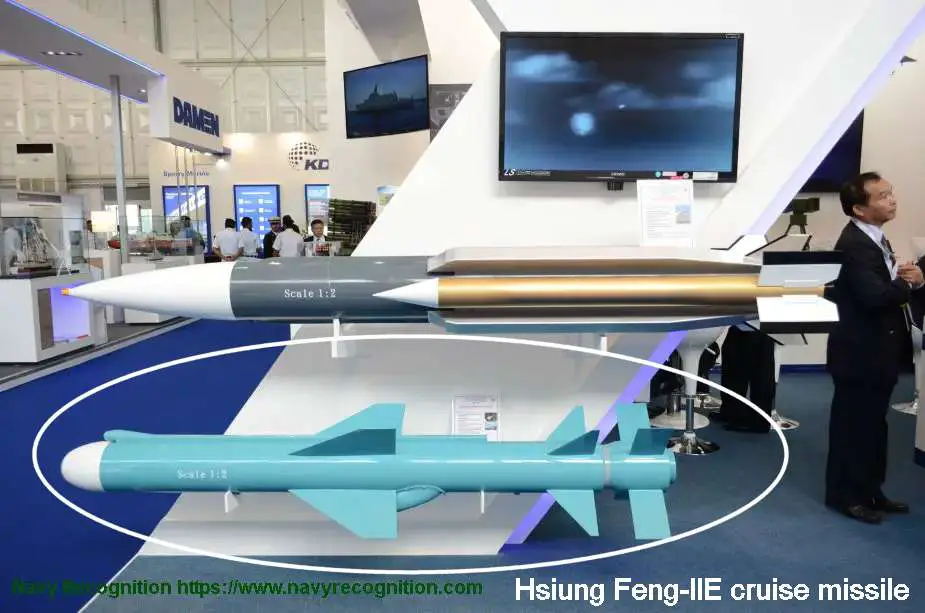Taiwan deploys 100 additional Hsiung Feng-IIE subsonic cruise missiles to target central China
Taiwan is deploying an additional 100 units of the advanced version of its ground missile, the Hsiung Feng-IIE (HF-IIE), revealed during tests last August. This new version, named Hsiung Sheng, is distinguished by its ability to hit targets up to 1,200 km away, including the center of the Chinese mainland.
Follow Army Recognition on Google News at this link

Taiwan NCSIST Hsiung Feng-IIE Surface-to-Surface Cruise Missile (Picture source: Army Recognition)
This enhancement of Taiwan's arsenal is part of a broad investment program of $534.93 million, aimed at consolidating the island's deterrence potential against China. This program has recently been completed, marking Taiwan's response to the incessant military maneuvers conducted by the People's Republic of China (PRC) in the vicinity of the island, notably the frequent overflights near the imaginary median line that divides the Taiwan Strait.
The operations of these missiles are entrusted to the 791st Brigade, located in Taoyuan and New Taipei City. Furthermore, the establishment of a new missile production unit within the National Chung-Shan Institute of Science and Technology (NCSIST) should allow for an increase in production capacity to more than 130 missiles per year.
The Hsiung Feng IIE (HF-2E), also known as the "Brave Wind IIE Cruise Missile," is a key component of Taiwan's arsenal, developed by the National Chung-Shan Institute of Science and Technology (NCSIST). This surface-launched cruise missile is powered by a locally developed turbofan engine, enhancing its strike capabilities with a standard range of 700 km, which can be extended beyond 1,200 km through technological advances and modifications. This missile aims to carry various types of warheads, including high-explosive and penetration warheads, to effectively engage various targets. The Hsiung Feng IIE could reach strategic targets located in the eastern and central regions of China, including near Shanghai and in Zhejiang Province. Designed in two variants, one to destroy bunkers and command centers with a high-explosive warhead, and the other aimed at airport infrastructure with cluster munitions, the Hsiung Sheng represents Taiwan's response to increasing military pressure from China.
The HF-2E incorporates advanced guidance systems, including inertial guidance complemented by GPS and TERCOM updates for navigation, and uses infrared imaging (IIR) for terminal guidance, ensuring precise strikes against its targets. With its development initiated in 2001 and becoming operational in 2011, the HF-2E reflects a significant effort by Taiwan to strengthen its defensive capabilities against potential threats.
Its design and operational strategy are distinct from its predecessor, the Hsiung Feng 2 anti-ship missile, reflecting operational flexibility and target engagement methods similar to those of the American Tomahawk cruise missile. The missile is designed for high subsonic speeds and a low-altitude approach to evade enemy defenses, making it a strategic asset for targeting military installations, especially air defense units and command centers.
The deployment strategy of the Hsiung Feng IIE involves ground-based mobile launchers, providing Taiwan with a mobile and responsive missile platform that can be deployed across various terrains and locations, enhancing the island's deterrence and defense posture.
Amid these tensions and China's territorial claims, Taiwan has significantly increased its defense investments, including a special budget for this missile's production and the development of enhanced naval and aerial capabilities. The island also plans to double its annual missile production, underscoring its commitment to maintaining a robust and autonomous defense. This autonomy is crucial, despite material support from the United States, as evidenced by the acquisition of Harpoon missiles.
However, the Hsiung Sheng has faced criticism for its performance, particularly its subsonic speed and lack of stealth, which could make it vulnerable to advanced detection systems. Additionally, limitations in reconnaissance and in-flight guidance adjustments could affect its accuracy and resistance to jamming.
It is important to remember that for the second consecutive year, the NCSIST has presented an operational budget exceeding NT$110 billion (equivalent to US$3.44 billion), as reported by the Liberty Times. The budget for 2024, newly disclosed, amounts to NT$110.85 billion, slightly lower than the NT$120.88 billion allocated for the year 2023.
Amid escalating tensions between Taiwan and China, the missile deliveries are expected to peak in 2024, with the NCSIST planning to supply over 1,000 missiles to Taiwan's armed forces during the year. This comprehensive missile inventory includes:
• 70 units of supersonic anti-ship Hsiung Feng III missiles
• A combination of 131 Hsiung Feng II anti-ship missiles and Hsiung Sheng cruise missiles
• 96 Sky Bow III (Tien Kung III) air defense missiles
- Hits: 4348
















